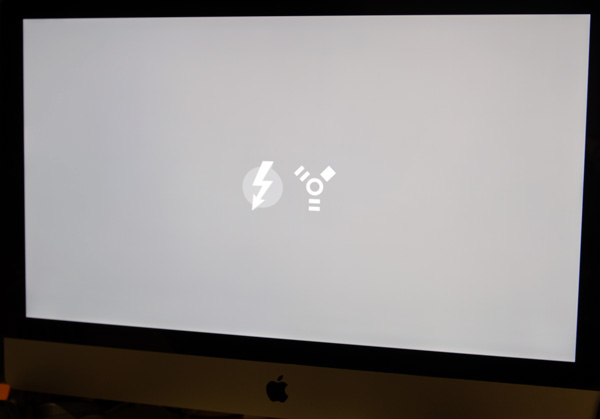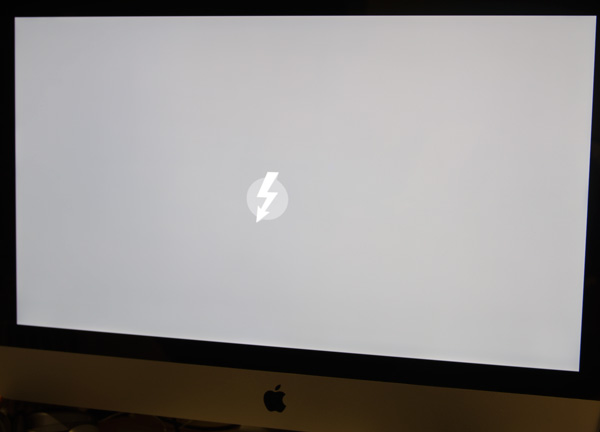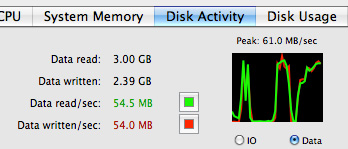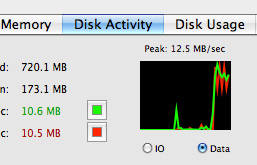Promise Pegasus R6 & Mac Thunderbolt Review
by Anand Lal Shimpi on July 8, 2011 2:01 AM ESTTarget Disk Mode
Another use of Thunderbolt is Target Disk Mode. Connect any two 2011 iMacs, 2011 MacBook Pros or any combination of the two with a Thunderbolt cable, reboot one of them while holding down the T key and you'll boot into target disk mode.

Hold down T and you'll get both Thunderbolt and FireWire logos at boot

With only Thunderbolt connected, the FireWire logo disappears - you're now in Target Disk Mode over TB
In this mode the target Mac boots into a special EFI state that allows all of its drives (HDDs, SSDs, optical, anything connected to the computer) to be mounted by the host Mac. The drives appear like normal removable disks on the host Mac:

MacBook Pro accessing the iMac's sole HDD over Thunderbolt in Target Disk Mode
You even have to eject them all manually before turning off the target Mac.
Don't get too excited though, since the target Mac isn't running full blown OS X it only implements basic storage drivers and optimizations. As a result, peak performance is no where near what Thunderbolt is capable of. Regardless of whether I put the 15-inch MacBook Pro or 27-inch iMac in target disk mode, I never saw more than 61MB/s from the target.

Performance was erratic as well. Sometimes I'd see transfer rates drop all the way down to 9MB/s before jumping up to 30MB/s and then 60MB/s. On average I'd say I saw transfers around 40MB/s.

The functionality is great, however I believe target disk mode would be a killer feature of Thunderbolt if it could operate at peak performance. In its current implementation, it's faster than a WiFi transfer but a bit slower than a good Gigabit Ethernet network transfer. If we could get line speed transfers, being able to move data between two modern Macs at multiple Gbps would be great.










88 Comments
View All Comments
etamin - Sunday, July 10, 2011 - link
hmm, I think I'm missing something here. Are you saying that the new MBPs have 12 lanes to the dGPU because 4 have been borrowed (on demand?) by the TB controller? or does the PCH has its PCI lanes? if so, how many? Thanks for the reply.repoman27 - Sunday, July 10, 2011 - link
Anand explained it in his review of the mid 2011 iMac, here: http://www.anandtech.com/show/4340/27inch-apple-im...etamin - Monday, July 11, 2011 - link
I see...I never noticed the PCH/SB always had PCI lanes of its ownrepoman27 - Saturday, July 9, 2011 - link
"At the end of a Thunderbolt chain you can insert a miniDP display, currently the only option is the 27-inch LED Cinema Display but in theory other panels that accept a miniDP input could work as well."Any DisplayPort enabled display will work, and there's plenty of those. You just need to use an asymmetrical cable. Just like you don't need a display with a mini/micro HDMI port to use the mini/micro HDMI out on the devices that have those. Or a PC with mini/micro USB ports.
mAxius - Sunday, July 10, 2011 - link
intel and apple will have thunderbolt the rest of the planet will have external pci express and usb who will winhttp://www.eetimes.com/electronics-news/4217190/PC...
Focher - Sunday, July 10, 2011 - link
According to that article, their standard is due for mid 2013. It's slower than TB and it's not even real. They've just announced plans to make something.repoman27 - Sunday, July 10, 2011 - link
“I'm not entirely convinced that we're limited by Thunderbolt here either - it could very well be the Pegasus' internal controller that's limiting performance.”I’m pretty sure what you’ve gone and done here is bumped into the ceiling imposed by the CPUs in those Macs only supporting a PCIe maximum TLP payload size of 128 bytes. You achieved a little better than 80% of the total 10 Gbps bandwidth available on one Thunderbolt channel in actual data throughput, which is surprisingly good. Even though that bandwidth is exclusive of PCIe’s normal 8b/10b encoding overhead, there’s no getting around the additional overhead inherent to any packetized protocol. A Thunderbolt controller paired with a northbridge that supports 4096 byte payload sizes could theoretically achieve around 99% of the full 10 Gbps.
You’ve also shown that one device using a single Thunderbolt channel can use > 50% of the bandwidth of the 4 PCIe 2.0 lanes connected to the Thunderbolt controller. Thus if you connected one 4-drive SF-2281 Pegasus R6 RAID-0 to each of the Thunderbolt ports on the 2011 iMac, you still shouldn’t expect more than 12,833 Mbps combined throughput.
The Target Disk Mode results are disappointing, although you’re always limited to the speed of the slowest drive that you’re transferring to/from. You didn’t mention what the iMac was packing, but if it’s still just the 1 TB 7200 RPM Seagate that was in the model you reviewed earlier, that would be the limiting factor. Did you check to see what you could pull using FireWire Target Mode between the two?
“simply displaying an image at 60Hz on the 27-inch Cinema Display requires over 6.75Gbps of bandwidth (because of 8b/10b encoding)”
I’m guessing that the 8b/10b encoding overhead is once again not present in the 10 Gbps per channel Thunderbolt bandwidth figure, just as for PCIe packets. Otherwise Thunderbolt would not be able to fully support the DisplayPort 1.1a spec which calls for 10.8 Gbps when including the 8b/10b padding.
“Apple claims that one of the channels is used for DisplayPort while the other is used for PCIe.”
This still flummoxes me. Does that mean that if you daisy chained 2 4-drive SF-2281 Pegasus R6’s to the Thunderbolt port on the MacBook Pro that you would achieve no better than 8021Mbps combined? That neither device could use the bandwidth of the second Thunderbolt channel even with no DisplayPort device present? Also, although Thunderbolt ports only support DisplayPort 1.1a resolutions, might they still support DP 1.2 features such as MST and daisy chainable displays? Or is the only way to connect multiple displays to one Thunderbolt port by using a DP 1.1a multi-display hub and thereby limiting the resolution of at least one of them to less than 2560x1440?
LedHed - Sunday, July 10, 2011 - link
By the time we have a decent amount of devices starting to use the Thunderbolt interface this will be outdated with the 2nd revision. Once again Apple is raising the price for no gain in anyway.LedHed - Sunday, July 10, 2011 - link
Also calling that huge array box mobile is hilarious in itself.xrror - Sunday, July 10, 2011 - link
So Apple will fix all the nagging issues with Thunderbolt connectivity when... they transition to ARM. Begone evil PC people, I'm sure Apple hates it thoroughly that iMacs and MBP can be "perverted" to x86's domain of Windows.So when MacOS basically is superseded by iOS for their "non-handheld mobile devices" and they finally eliminate iMac and MBP since "people who didn't transition to our new taint-ARM/Apple specific processor" line of devices are obviously just lame, as proven by the poor saps holding on to their PowerPC macs. Yea it's coming full circle.
Ugh... I really hope I'm just being paranoid/joking. But...